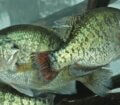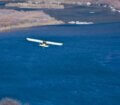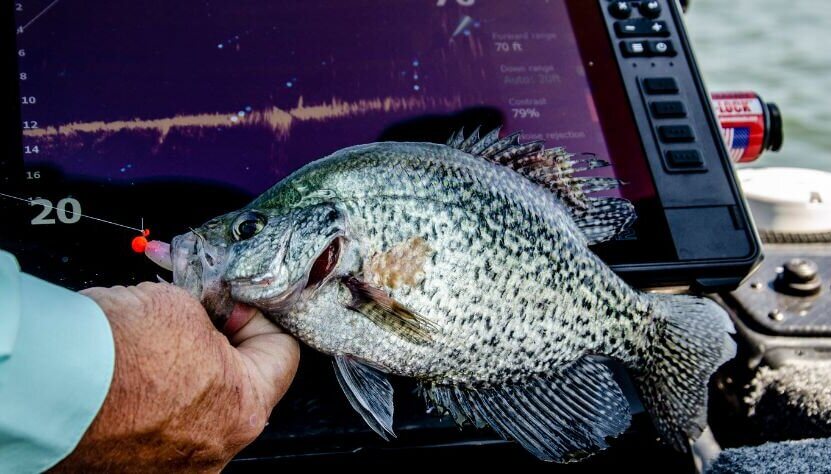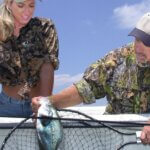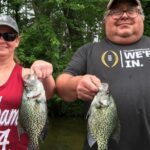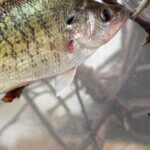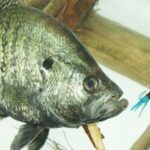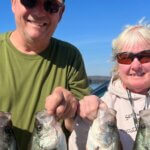Editor’s Note: With the strategies you’ll learn this week, you can develop a game plan on how to fish a new lake. With this information, a large number of potential crappie hotspots will come to mind. However, depending on the time of year you plan to fish, you also must consider where the crappie will be along their seasonal migration routes.
Use a Lake Map That Shows Underwater Elevations: Success in pinpointing crappie on a new lake first requires a map of that lake. Attempt to find a lake map that shows underwater elevations. Professional bass fisherman Larry Nixon of Bee Branch, Arkansas, the winner of a Bassmaster Classic and almost $4 million fishing, helped me learn how to read lake maps and look for bottom structure like points that will hold crappie and bass. “These points create natural intersections on which crappie congregate,” Nixon explained. “Often you’ll locate stumps and brush where crappie hold along these underwater points. Next, search for underwater feeder creeks that intersect with underwater creek channels, which also offer highly-productive bass and crappie fishing.”
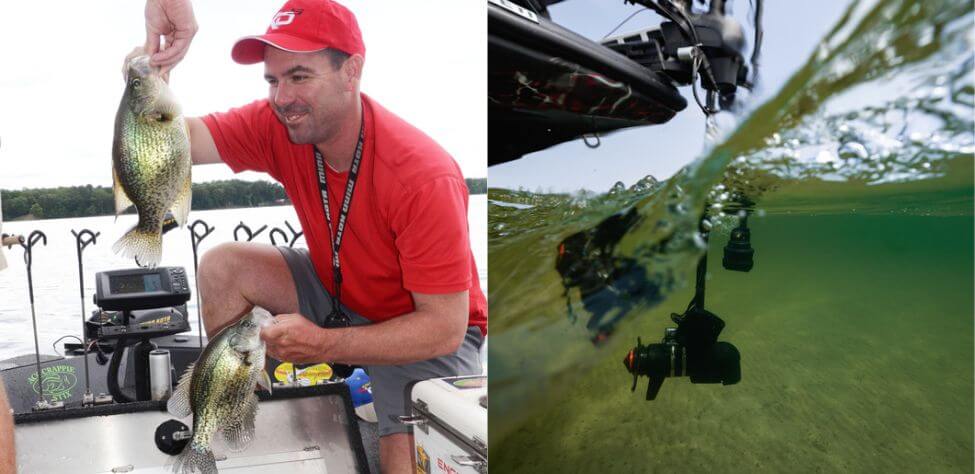
Fish Underwater Humps You Locate: Although many crappie fishermen target standing timber or other visible cover they can see coming out from the bank, will you see crappie anglers fishing the humps in the middle of a lake. But these humps do concentrate baitfish and provide vertical relief for crappie to hold at different water depths, depending on the oxygen level and the water temperature.
Search for Standing Timber: If I’ve talked with someone about a lake and know that certain bays and coves have standing timber in them, I look on the lake map for underwater creek channels or ditches that run through the standing timber. I usually locate the most crappie in the standing timber closest to the edge of the creek channel, except in the springtime of the year.
Fish Bridge Structure for Crappie: I pinpoint bridges on a lake too. Most crappie fishermen realize that bridge pilings on the edges of creek channels offer better-than-average fishing for crappie. But I only fish bridges on a new lake when I get caught in a rainstorm and need overhead cover, or when I fish at night during the hot summer months because local anglers fish bridge pilings heavily.
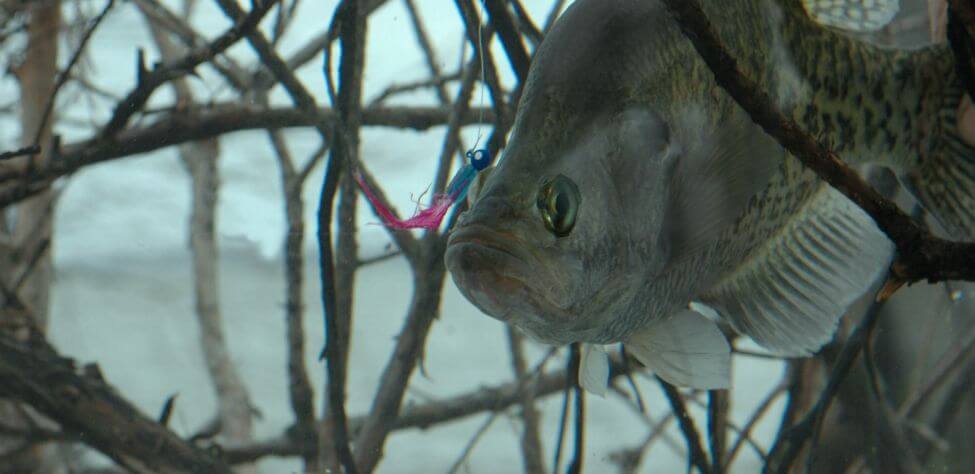
Use Forward-Facing Sonar: One of the new ways to discover crappie is to pinpoint them in open water. The secret to this technique is to first determine where bait schools are holding and moving. Look for suspended crappie in relationship to schools of shad with your forward-facing sonar. Other crappie will be holding on the edges and/or behind or below the schools of bait. Using forward-facing sonar enables you to know how far your boat is from crappie, where you need to position your boat to cast to crappie without spooking them. Also you can pinpoint the largest crappie in a school and fish for those individual fish. I’ve heard tournament crappie fishermen say often, “You’ll either win a tournament with forward-facing sonar or lose to someone who’s using it.”
As nationally-known tournament crappie angler and fishing guide, Jonathan Phillips of Wetumpka, Alabama, told me, “I once spider rigged (trolled) for crappie. But today I can locate and catch crappie much quicker with forward-facing sonar than by trolling.”
Tomorrow: Do Aerial and Boat Reconnaissance for Crappie
Expert Guidebooks on Crappie Fishing: Best Sellers
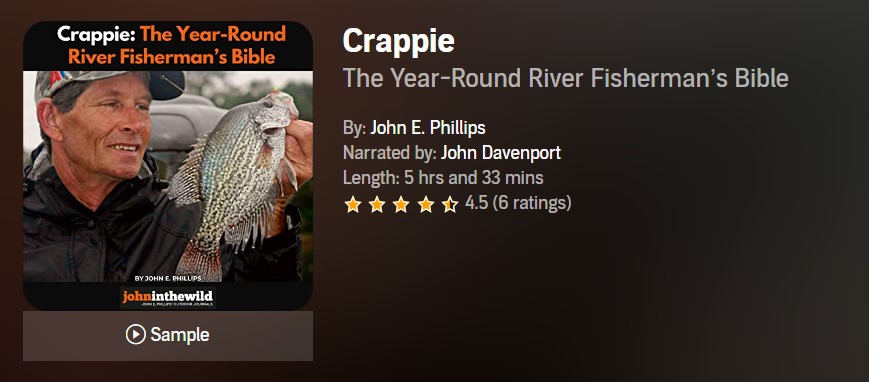
Fishing rivers for crappie and being able to find and catch speckled sides consistently has long been one of the mysteries in the crappie-fishing world.
“One of the reasons that river systems are so difficult to fish is because the water’s either rising or falling in them,” says Ott DeFoe, the 2019 Bassmaster Classic champion.
Rivers also are very susceptible to floods and droughts and constantly have current moving through them. Often fast current or slow current in rivers is created by rain or droughts upstream. When rivers flood, they can wash away fish habitat like logs, sunken trees, manmade brush piles and stake beds. But that’s the time when a river also creates new crappie hot spots that haven’t been available to the crappie or the fishermen before the flood.
Because river systems are so unpredictable, I’ve felt the best way to get the most useful information on how to fish rivers for crappie is to talk to numbers of anglers all over the nation to learn their best tactics.
In this book, I’ve gleaned crappie-fishing wisdom from three dozen crappie anglers and guides from a dozen states, who consistently catch crappie at all times of the year. The tournament crappie fishermen in this book fish most of the country at different times of the year on various river systems and lakes. And, these anglers use techniques you never may have considered, including:
- Setting up a casting ring with your electronics to keep you from getting too close to the crappie that are holding on underwater structure, while you’re fishing all the way around the structure;
- Buying an automotive laser temperature gauge to measure water temperature
- Evaluating the most-productive places to sink brush and other structure, according to prevailing wind direction, the crappie’s summer, fall, winter, and spring migration patterns, and other factors.
VERSIONS: AUDIBLE, KINDLE & PRINT
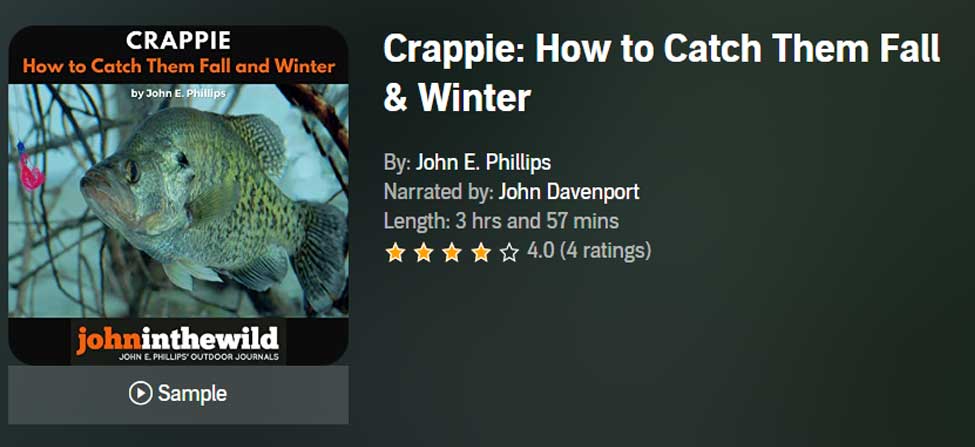
Crappie: How to Catch Them Fall & Winter
Yes, you can catch and eat crappie during the fall and winter months. Often, at many places, you’ll catch more and bigger crappies in the fall and winter than you do in the spring and summer. To learn where to find and how to catch cooler weather speckled sides, we’ve interviewed a wide variety of some of the nation’s best tournament crappie fishermen and guides.
Many of the individuals you’ll hear about in this audiobook are tournament crappie pros who travel the country to fish in crappie tournaments from New York to Florida and from Virginia to California. They use the latest crappie-finding equipment, the best poles, rods, reels, line, and the most-productive baits. Each of the people mentioned in this book has the ability to be dropped out of an airplane anywhere in the United States and catch crappie on any lake close to where they land that contains crappie.
From over 50 years of crappie-fishing experience, I’ve learned that you get the best advice by interviewing a large number of people who have different tactics and fish under various water, weather, and fishing-pressure conditions.
In this book, you will learn:
- How to spider-rig (slow-troll), which is one of the fastest-growing techniques for catching the most and biggest crappies in the shortest time
- How to catch crappie on crank baits and when and where using a crank bait is the most appropriate
- How to find areas of any lake that will hold large schools of crappies during the winter months – places you can return to time and again and expect them to be there
- Why competing in crappie tournaments is one of the quickest ways to learn how to catch more and bigger crappie faster
- Why and how to look for and catch the biggest crappie in a lake
VERSIONS: AUDIBLE, KINDLE & PRINT
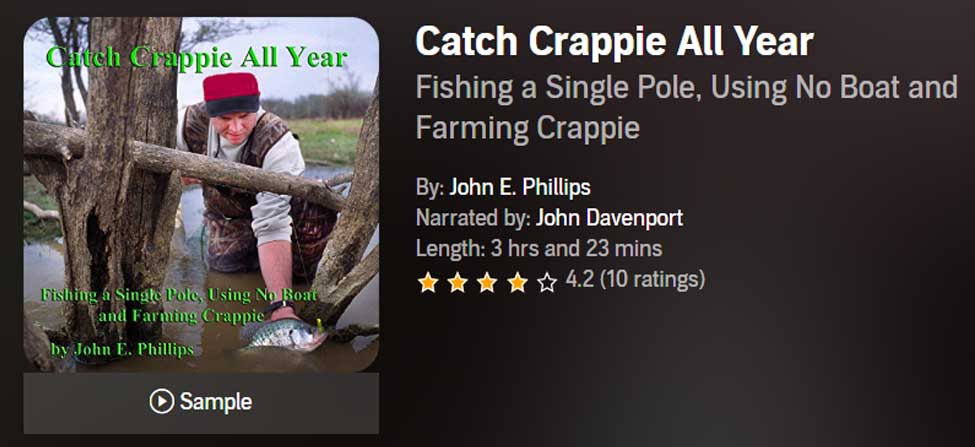
Catch Crappie All Year: Fishing a Single Pole, Using No Boat, and Farming Crappie
I’ve interviewed some of the best crappie fishermen in the nation for my new audiobook, Catch Crappie All Year: Fishing a Single Pole, Using No Boat and Farming Crappie to learn how, where, and when to catch the most crappie with or without a boat while single-pole fishing. I’ve also included information on how to grow a crop of crappie to catch every day of the year. Although I’ve fished in fully rigged crappie boats costing $45,000 – $90,000-plus that can have up to 16 rods at one time to slow troll, I still enjoy….
- Watching a quill cork sink in a brush top
- Fishing with an ultralight spinning rod
- Reeling jigs or minnows along a grass line and feeling that thud when a crappie takes the bait
- Fishing with family and friends, even if we all can’t fit in one boat
- Participating in less-expensive and hassle-free yet highly-productive crappie fishing like single poling
I’ve tried to capture in this new audiobook the old way of crappie fishing with new twists and detailed tactics to aid you in catching crappie all year.
VERSIONS: AUDIBLE, KINDLE & PRINT
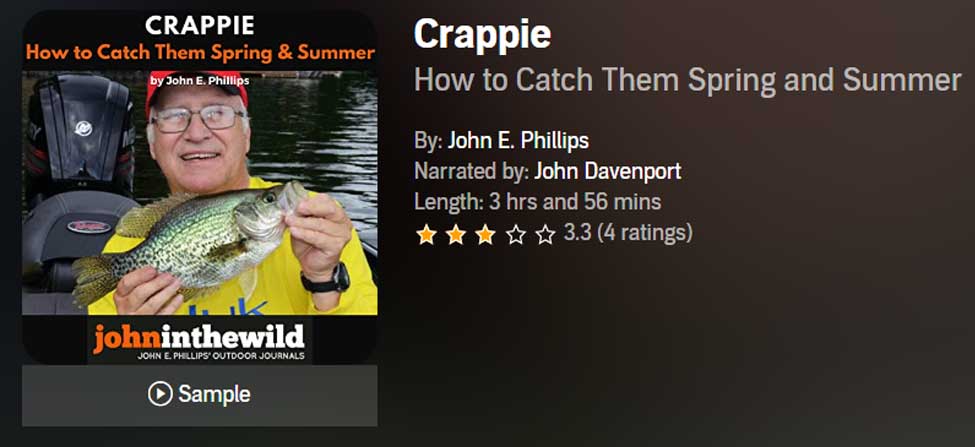
Crappie: How to Catch Them Spring and Summer
You can catch crappie all year long if you know where to find them and what techniques to use to catch them. However, crappie fishing is so technical these days, and we’ve learned so much about how to crappie fish because of the professional crappie-fishing circuits, that one book can’t hold all the information.
This book is the first of a three-part series on how, where, and when to catch crappie, with the best crappie fishermen in the nation. Many of these men have proven they are the best, because they’ve won crappie-fishing tournaments or been successful fishing guides for many years.
This audio version of Crappie: How to Catch Them Spring and Summer includes crappie pros like Ronnie Capps, who has won seven national championships and over $1 million with his partner Steve Coleman.
We also have Malcolm Lane, Stokes McClellan from North Carolina, Billy Blakeley from Reelfoot Lake, John Woods, Kent Driscoll, fishing biologist and professional basser Ken Cook, and many others. We asked the questions that crappie fishermen want answered about how to find and catch crappie during the spring and summer months, and these fishing tips are the result.
In the world of crappie fishing, no one man knows it all, and that’s why I’ve interviewed so many fishermen, asked so many questions, and tried to get so many answers for you about how to fish.
VERSIONS: AUDIBLE, KINDLE & PRINT

